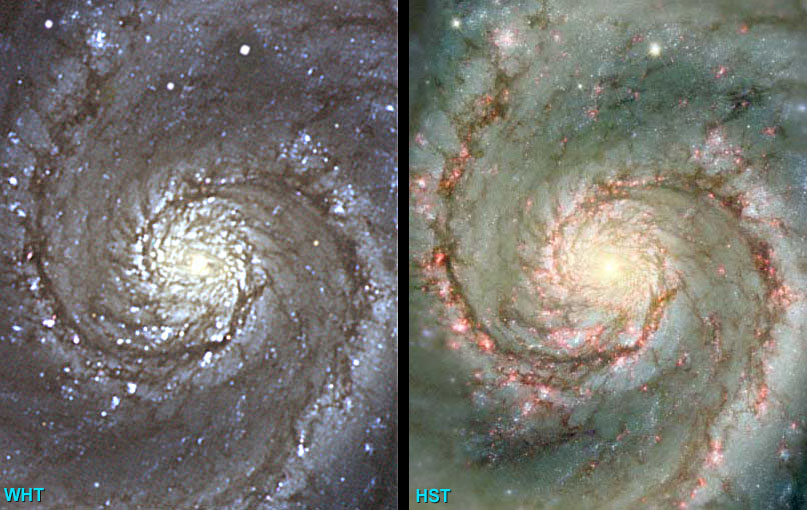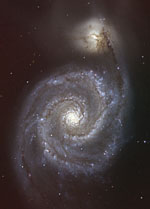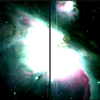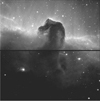Astronomical Image Archive
Permanent link to this search: https://astro.ing.iac.es/s/?97c540| #1 | 
NGC 660
| Full record: 1886Description: Detector: Red+4.
Filters and exposure times: This composite image was obtained in Johnson-Bessel BVR filters taken during the first light of PFIPs Red+4 detector on the 27th of September 2013. The combined total exposure time was 40 minutes. |
| | #2 | 
NGC 7217
| Full record: 1887Description: The spiral galaxy NGC 7217 in Pegasus. Detector: EEV. Filters and exposure times: B, V and R. PDF version: https://www.ing.iac.es/PR/dissemination/NGC7217.pdf Telescope: WHT Instrument: PFIP Credit: Mischa Schirmer (ING) and Gilles Bergond (IAA, Granada). Date: 1 January 2005 |
| | #3 | 
M83 Galaxy.
| Full record: 1956Description: PFIP on William Herschel Telescope, CCD#1. PDF version: https://www.ing.iac.es/PR/dissemination/M83.pdf Telescope: WHT Instrument: PFIP Credit: Chris Benn (ING), Nik Szymanek (University of Hertfordshire). Date: 17 February 2004 |
| | #4 | 
M51
| Full record: 1925Description: A comparison between the M51 image taken using the PFC on the WHT and an image of the same object from Hubble Space Telescope Heritage Project. M51 galaxy, known as The Whirlpool Galaxy, is a bright spiral galaxy fairly close to us (7.5 Megaparsecs = 25 million light years). To the north of M51, at the bottom of the picture, is a companion galaxy which is being disrupted by the gravitational tidal forces of the main galaxy. Telescope: WHT Instrument: PFIP Credit: Javier Mendez, Nik Szymanek and HST Heritage Project. Date: 1 April 2001 |
| | #5 | 
M51
| Full record: 1924Description: M51 galaxy, known as The Whirlpool Galaxy, is a bright spiral galaxy fairly close to us (7.5 Megaparsecs = 25 million light years). To the north of M51, at the bottom of the picture, is a companion galaxy which is being disrupted by the gravitational tidal forces of the main galaxy. True-colour image of M51 using the prime focus camera on the WHT. Filter B is blue, filter V is green and filter R is red. Exposure time was 300s in each band. PDF versions: https://www.ing.iac.es/PR/dissemination/M51.pdf, http://www.ing.iac.es/PR/dissemination/m51_poster.pdf Telescope: WHT Instrument: PFIP Credit: Javier Mendez (ING) and Simon Tulloch (ING). Date: 1 June 2000 |
| | #6 | 
M42
| Full record: 1834Description: This is the star-formation region M42, also known as the Orion nebula. The gas and dust in the nebula emits light because it is irradiated by nearby emerging stars. Located at a distance of about 1,600 light years, the Orion nebula is the brightest diffuse nebula in the sky, visible to the naked eye. It is the main part of a much larger cloud of gas and dust which extends over 10 degrees well over half the constellation Orion. 10s true-colour images using BVR imaging on the WHT prime focus camera. PDF version: https://www.ing.iac.es/PR/dissemination/orion.pdf Telescope: WHT Instrument: PFIP Credit: Simon Tulloch (ING) and Nik Szymanek. Date: 1 January 1999 |
| | #7 | 
M42
| Full record: 1835Description: This is the star-formation region M42, also known as the Orion nebula. The gas and dust in the nebula emits light because it is irradiated by nearby emerging stars. Located at a distance of about 1,600 light years, the Orion nebula is the brightest diffuse nebula in the sky, visible to the naked eye. It is the main part of a much larger cloud of gas and dust which extends over 10 degrees well over half the constellation Orion. 10s true-colour images using BVR imaging on the WHT prime focus camera. PDF version: https://www.ing.iac.es/PR/dissemination/orion.pdf Telescope: WHT Instrument: PFIP Credit: Simon Tulloch (ING) and Nik Szymanek. Date: 1 January 1999 |
| | #8 | 
Horse Head Nebula
| Full record: 1844Description: The Horse Head Nebula. This dark dust nebula, in the shape of a horses head, protrudes into a bright emission nebula, IC 434, in the constellation Orion. A nearby naked-eye star illuminates the surface of an otherwise invisible dusty cloud, exciting the distinctive red emission from hydrogen. From this dark cloud projects yet more dust, which has the shape of the head of a horse, seen in silhouette against the glowing background. 10s exposure using the 2-detector prime focus camera on the WHT. PDF version: https://www.ing.iac.es/PR/dissemination/horse.pdf Telescope: WHT Instrument: PFIP Credit: Simon Tulloch (ING) and Nik Szymanek (SPA). Date: 1 January 1999 |
| | #9 | 
M33 Galaxy
| Full record: 1920Description: This galaxy is one of the finest examples of a spiral galaxy in the sky and is about one degree across. The galaxy is a member of the 30 or so galaxies of the Local Group and is close enough - about 2.5 million light years - for us to study the anatomy of a galaxy in great detail. Many individual bright stars pepper the delicate spiral arms which are in turn sprinkled with pink star-forming regions. Several of the clumps of bright stars and their associated nebulae are bright enough to have been catalogued as separate objects. It is a CCD true-colour composition achieved with the 2 detector WHT Prime Focus camera. Exposure time was 10s. PDF version: http://www.ing.iac.es/PR/dissemination/m33.pdf Telescope: WHT Instrument: PFIP Credit: Courtesy L. Magrini and M. Perinotto (University of Florence), R. Corradi (ING), and A. Mampaso (IAC). Date: 1 January 1999 |
| | #10 | 
M33 Galaxy
| Full record: 1921Description: This galaxy is one of the finest examples of a spiral galaxy in the sky and is about one degree across. The galaxy is a member of the 30 or so galaxies of the Local Group and is close enough - about 2.5 million light years - for us to study the anatomy of a galaxy in great detail. Many individual bright stars pepper the delicate spiral arms which are in turn sprinkled with pink star-forming regions. Several of the clumps of bright stars and their associated nebulae are bright enough to have been catalogued as separate objects. This image is a 3-colour photographic composition from the Isaac Newton Telescope. Telescope: WHT Instrument: PFIP Credit: Malin-IAC-RGO. Date: 1 January 1992 |
|
|



